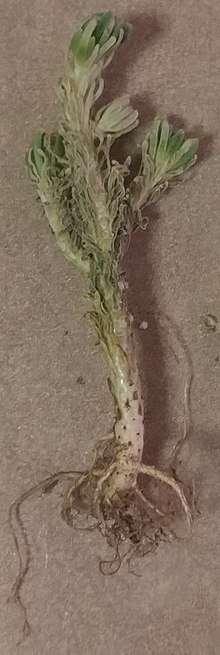Sedum multiceps
| Sedum multiceps | |
|---|---|
 | |
| S. multiceps juvenile with root system exposed | |
| Scientific classification | |
| Kingdom: | Plantae |
| (unranked): | Angiosperms |
| (unranked): | Eudicots |
| (unranked): | Core eudicots |
| Order: | Saxifragales |
| Family: | Crassulaceae |
| Genus: | Sedum |
| Species: | S. multiceps |
| Binomial name | |
| Sedum multiceps | |
Sedum multiceps, also known as miniature/pygmy Joshua tree, is a perennial, deciduous species of Sedum from the Crassulaceae family of succulent plants, native to Algeria.[1] The plant is nicknamed for its glaucous leaves that grow in clusters, resembling Yucca brevifolia. It was named officially as a distinct species in 1862.
Description
S. multiceps has a many-branched, shrubby habit, and consists of grayish-green leaves growing at the tips of its branches. It grows shallow roots and mats of short woody stems which spread rapidly across large areas, and sprouts bright yellow, star-shaped flowers in late summer.[2]
Cultivation
S. multiceps is cultivated as an ornamental plant, typically for planting in containers or in gardens as groundcover. It needs very little attention, and tolerates all but the most loamy soil.
References
- ↑ USDA, Agricultural Research Service, National Plant Germplasm System (2018). "Taxon: Sedum multiceps Coss. & Durieu". Germplasm Resources Information Network. Retrieved June 8, 2018.
- ↑ Cullen, James; Knees, Sabrina G.; Cubey, H. Suzanne, eds. (2011). The European Garden Flora Flowering Plants: A Manual for the Identification of Plants Cultivated in Europe, Both Out-of-Doors and Under Glass. Cambridge University Press. ISBN 9780521761512.
External links
- Sedum multiceps at IPNI
- Sedum multiceps at World of Succulents